
Maya Ying Lin is an American designer and sculptor. In 1981, while an undergraduate at Yale University, she achieved national recognition when she won a national design competition for the planned Vietnam Veterans Memorial in Washington, D.C.

Frank Philip Stella is an American painter, sculptor and printmaker, noted for his work in the areas of minimalism and post-painterly abstraction. Stella lives and works in New York City.

Sir Richard Julian Long, is an English sculptor and one of the best-known British land artists.
Anya Gallaccio is a British artist, who creates site-specific, minimalist installations and often works with organic matter.

Dan Flavin was an American minimalist artist famous for creating sculptural objects and installations from commercially available fluorescent light fixtures.
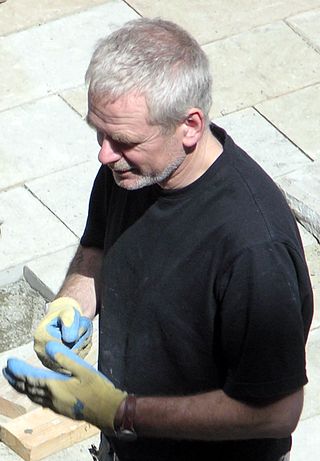
Andy Goldsworthy is an English sculptor, photographer, and environmentalist who produces site-specific sculptures and land art situated in natural and urban settings.
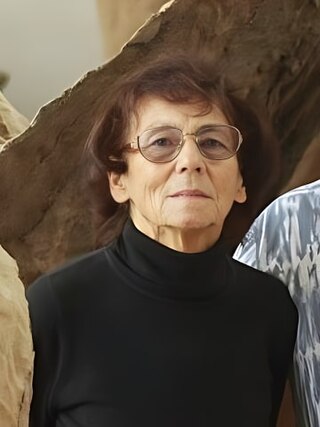
Magdalena Abakanowicz was a Polish sculptor and fiber artist, known for her use of textiles as a sculptural medium and outdoor installations.
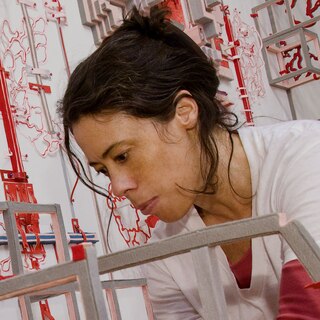
Diana Cooper is an American visual artist, known for largely abstract, improvised hybrid constructions that combine drawing, painting, sculpture, installation and photography. Her art has evolved from canvas works centered on proliferating doodles to sprawling installations of multiplying elements and architectonic structures. Critics have described her earlier work—primarily made with craft supplies such as markers, pens, foamcore, pushpins, felt, pipe cleaners, tape and pompoms—as humble-looking yet labor-intensive, provisional and precarious, and "a high-wire act attempting to balance order and pandemonium." They note parallels to earlier abstract women artists such as Eva Hesse, Lee Bontecou, Elizabeth Murray, and Yayoi Kusama. Lilly Wei, however, identifies an "absurdist playfulness and Orwellian intimations" in Cooper's work that occupy a unique place in contemporary abstraction.

Don Gummer is an American sculptor. His early work concentrated on table-top and wall-mounted sculpture. In the mid-1980s, he shifted his focus to large free-standing works, often in bronze. In the 1990s, he added a variety of other materials, such as stainless steel, aluminum and stained glass. His interest in large outdoor works also led him to an interest in public art. He is the husband of actress Meryl Streep.

Environmental art is a range of artistic practices encompassing both historical approaches to nature in art and more recent ecological and politically motivated types of works. Environmental art has evolved away from formal concerns, for example monumental earthworks using earth as a sculptural material, towards a deeper relationship to systems, processes and phenomena in relationship to social concerns. Integrated social and ecological approaches developed as an ethical, restorative stance emerged in the 1990s. Over the past ten years environmental art has become a focal point of exhibitions around the world as the social and cultural aspects of climate change come to the forefront.

Roni Horn is an American visual artist and writer. The granddaughter of Eastern European immigrants, she was born in New York City, where she lives and works. She is currently represented by Xavier Hufkens in Brussels and Hauser & Wirth. She is openly gay.

Nnenna Okorelisten is an Australian-born Nigerian artist who lives and works in Chicago at North Park University, Chicago. Her largely abstract sculptural forms are inspired by richly textured forms and colors within the natural environment. Okore's work frequently uses flotsam or discarded objects to create intricate sculptures and installations through repetitive and labor-intensive processes. She learnt some of her intricate methods, including weaving, sewing, rolling, twisting and dyeing, by watching local Nigerians perform daily domestic tasks. In her more recent works, Okore uses plant-based materials to create large bioplastic art forms and installations. Her work has been shown in galleries and museums within and outside of the United States. She has won several international awards, including a Fulbright Scholar Award in 2012. and the Australian Creative Victoria Award in 2021.

Mark Chai is a Native Hawaiian sculptor who designs and handcrafts fine woods and recycled materials into modern lamps, sculpture, large installations and furniture.

Jessica Stockholder is a Canadian-American artist known for site-specific installation works and sculptures that are often described as "paintings in space." She came to prominence in the early 1990s with monumental works that challenged boundaries between artwork and display environment as well as between pictorial and physical experience. Her art often presents a "barrage" of bold colors, textures and everyday objects, incorporating floors, walls and ceilings and sometimes spilling out of exhibition sites. Critics suggest that her work is informed by diverse artistic traditions, including abstract expressionism, color field painting, minimalism and Pop art. Since her early career, they have noted in her work an openness to spontaneity, accident and marginality and a rejection of permanency, monetization and disciplinary conventions that Stephen Westfall characterized as an "almost shocking sense of freedom."

Alyson Shotz is an American sculptor based in Brooklyn, New York. She is best known for experiential, large-scale abstract sculptures and installations inspired by nature and scientific concepts, which manipulate light, shadow, space and gravity in order to investigate and complicate perception. Writers suggest her work challenges tenets of monumental, minimalist sculpture—traditionally welded, solid, heavy and static—through its accumulation of common materials in constructions that are often flexible, translucent, reflective, seemingly weightless, and responsive to changing conditions and basic forces. Sculpture critic Lilly Wei wrote, "In Shotz’s realizations, the definition of sculpture becomes increasingly expansive—each project, often in series, testing another proposition, another possibility, another permutation, while ignoring conventional boundaries."
Naz Shahrokh is an Iranian-born visual artist and educator. She is a conceptual artist and has worked in many mediums, including Persian miniature painting, sculpture, site-specific installation, land art, and video art. Shahrokh lives in Abu Dhabi, and has previously lived in Paris, Los Angeles, and Brooklyn.
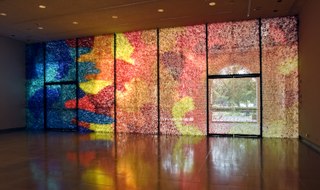
Lisa Hoke is an American visual artist based in New York City and Hudson Valley, New York. She is known for colorful, immersive installations and abstract sculptures characterized by labor-intensive working processes and inventive use of repurposed consumer detritus as raw materials. Her work has often challenged notions of mastery, permanence and fixed meaning, embracing qualities such as contingency and transience. In early sculptures, she tested gravity and balance with intuitively arranged, tenuous suspensions; her later large-scale installations are created on-site and dismantled after exhibition, their materials saved for future re-use. Hoke first gained recognition in the 1990s as one of a number of sculptors that mined the domestic sphere for materials and ideas, in her case, mixing elements of formalism and postminimalism, Pop assemblage, and social, often feminist, commentary. In the 2000s, critics have compared the bright, swirling forms and textures of her installations to the varied surfaces of Antoni Gaudí and the sparkling patterns of Seurat and Klimt.

Barbara Cooper is an American artist whose practice encompasses abstract sculpture, public and installation art, drawing and set design. She is most known for her sculpture, which emphasizes process, handcraft, and its basis in natural forms and processes of transformation, such as growth, protection and regeneration. Critic Polly Ullrich writes that "Cooper's hand-intensive art is an art of condensation" that takes "the flow of time and growth as a subject"; that quality often leads writers to align Cooper with postminimalism. John Brunetti describes her work as "sinuous, tactile sculptures [that] quietly juxtapose conceptual and formal dichotomies, among them the organic and man-made, the feminine and the masculine, movement and stasis."

Heide Fasnacht is a New York City-based artist who works in sculpture, drawing, painting and installation art. Her work explores states of flux, instability and transformation caused by human action and natural events. Since the mid-1990s, she has been known for sculptures and drawings that recreate momentary phenomena such as sneezes, geysers and demolitions—in sometimes abstract or cartoony form—that are temporally and spatially "frozen" for consideration of their aesthetic, perceptual, social or sensate qualities. In the late 2010s, she has expanded these themes in paintings that examine lost and neglected childhood sites, such as playgrounds and amusement parks. ARTnews critic Ken Shulman has described her work as "chart[ing] the fluid dialogue between second and third dimensions, motion and inertia, creation and ruin."
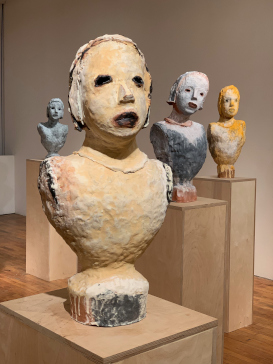
Elise Siegel is an American sculptor and installation artist based in New York City. She is known for several bodies of figurative work that use subtle and ambiguous gesture and facial expression to evoke psychic and emotional states. In the 1990s, she first gained recognition for garment-like constructions that blurred boundaries between clothing, skin and body, critiquing the roles fashion and plastic surgery play in the construction of sexual and cultural identity; writer Mira Schor included Siegel among the cohort of artists she dubbed "Generation 2.5" and credited for developing the tropes of feminist art. After shifting to clay as her primary material, Siegel was one of a number of artists in the 2000s whose work spurred a rebirth in figurative ceramics emphasizing emotional expression, social conditions, identity and narrative. Her ceramic work—which ranges from roughly modeled portrait busts to highly charged, theatrical installations—is said to capture fleeting moments of internal struggle, conflict and vulnerability, creating a psychological tension with the viewer.





















